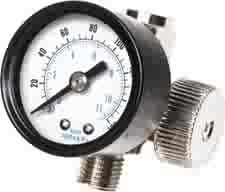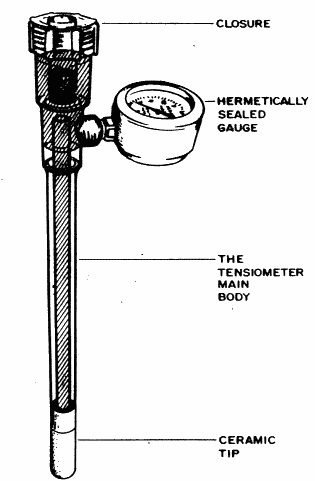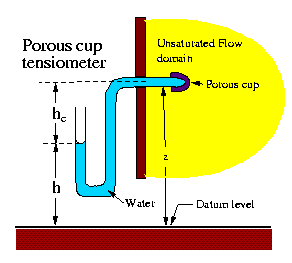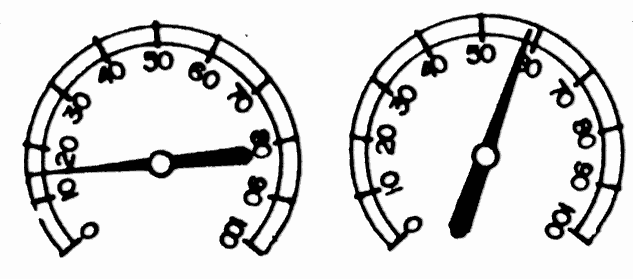The most commonly read gauge on a farm is normally that of a tensiometer and pressure gauges.
Tensiometer: A device for estimating soil moisture levels by measuring the negative hydraulic pressure of water in soil; a porous, permeable ceramic cup connected through a tube to a manometer or vacuum gauge. (It works exactly like the root of a plant).
Irrigation requires a relatively high investment in equipment, fuel, maintenance and labour, but offers significant potential for increasing net farm income. The frequency and timing of water application have a major impact on yields and operating costs.
To schedule irrigation for the most efficient use of water and to optimise production, it is desirable to frequently determine the soil water conditions throughout the root zone of the crop being grown. A number of methods for doing this have been developed and used with varying degrees of success, but the two methods, which have proven most practical for field use, are tensiometers and electrical resistance meters.

Click here to view a video that explains the pressure gauge.
A tensiometer is a sealed water-filled tube, equipped with a porous tip installed in the ground to the desired root zone (Figure 1). In dry soil, water is drawn out of the instrument, reducing the water volume in it and creating a partial vacuum. This is registered on the gauge. The drier the soil, the higher the reading. Irrigation reverses this action. The vacuum created by dry soil draws water back into the instrument from the soil. This in turn results in a lower gauge reading.


Figure 1: Typical tensiometer and its parts. Source: James (1988).
The instrument is in effect a “dummy root,” equipped with a gauge that continuously registers how hard the roots are working. A gauge reading of 50 indicates the same amount of moisture whether in sandy or clay soil. Because of the tensiometer’s unique principle of operation, it needs no calibrations, under normal operating conditions, for various types of soil. The extension worker or grower can plot the tensiometer readings on a graph during the growing season. Such a record is useful in planning future irrigation requirements and making year-to-year comparisons. Generally, tensiometers continuously show the available soil moisture in the crop’s root zone. The tensiometer covers the entire range of soil moisture required for maximum growth. Growers quickly learn the range of tensiometer readings in which they should start or stop irrigation to produce the best results for their crops and conditions. The following interpretations of tensiometer readings have proven practical or useful under field conditions (also see Figure 2).

Figure 2. Tensiometer readings. Source: James (1988). Note: The reading on the left says soil has adequate water; the one on the right says soil moisture is low.
Reading
Readings 0 - 10: Saturated soil - These readings often occur for a day or two following irrigations. Continued readings in this range indicate over-irrigation, the danger of waterlogged soils, inadequate root aeration, root rot, or a high water table.
Readings 10 - 30: Field capacity - Farmers should discontinue irrigations when readings in this range occur, to prevent waste of water through percolation and waste of nutrients through leaching.
Readings 30 - 60: Usual range for starting irrigations - Root aeration occurs anywhere in this range. In general, in hot dry climates or coarse-textured soils, farmers should start irrigating when they see readings in the lower part of this range; in the upper part of this range, in cool, humid climates or soils with high water-holding capacity. Starting irrigations in this range ensures readily available soil moisture at all times, which is essential for maximum growth. It also provides a safety factor, with a reserve of soil moisture to compensate for such practical problems as delayed irrigations or the inability to obtain a uniform distribution of water to all portions of the crop.
Readings 70 and higher: Stress range - A reading of 70 does not necessarily indicate that the crop is using all available moisture, but that readily available moisture is getting dangerously low for ensuring maximum growth.
Readings of 80 - 85: Top range of accuracy of the tensiometers - The number of tensiometers for an installation varies widely with crop and local conditions.
Measuring Soil Moisture With Tensiometers
The position in the field where the tensiometers will be installed must represent large sections of a field. Three tensiometers, one each, at a depth of 30, 60, and 90cm etc. in accordance with the effective root zone must be installed in a group to form a measurement station.
Note the following important points when installing tensiometers:
|
Step: |
Action: |
|
1 |
Fill the tensiometers with water that was boiled and then cooled. They must then be left for a few days until all the pores in the ceramic tip are saturated with water. |
|
2 |
Use a soil auger to make a hole slightly shallower than the length of the tensiometer. In the bottom of this hole, a small hole is pressed using a metal pipe of the same diameter as that of the tensiometer. The full length of the ceramic tip must fit into the small hole. |
|
3 |
Press the tip of the tensiometer into the small hole. For accurate readings, the ceramic tip must be in close contact with the soil. Fill the opening around the shaft with moist soil and ram the soil down so that water penetration will be normal. |
|
4 |
Fill the tensiometer with water that was boiled and then cooled. The water in the tensiometer must be replenished daily after the reading was taken. Use a small vacuum pump for sucking the air out of the tensiometer. |
|
5 |
Record the suction tensions early in the morning of every day and plot the values on a graph. |
The tensiometer indicates the stress experienced by the plant while it absorbs water. Young crops must be irrigated as soon as the tensiometer at a depth of 30 cm, registers a value of 35 kPa. Older cotton must be irrigated as soon as the tensiometer at a depth of 60 cm registers a value of 4O kPa. The tensiometer at the maximum depth is used to indicate over irrigation and it must always register a value larger than l0 kPa. Tensiometers can also be calibrated to indicate the amount of water required to wet the soil profile to field capacity.